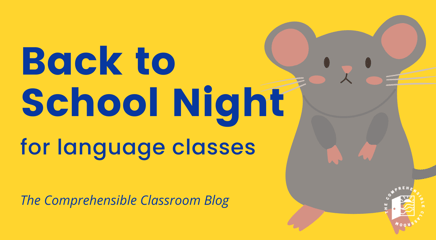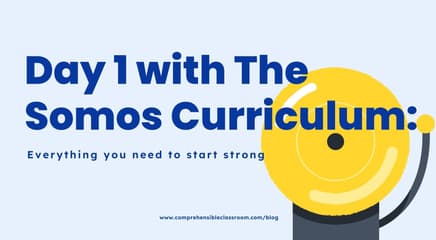The first question that I heard after the presentation was what curriculum I use to prepare my novice students to read about culture early on in the year. This is the background reading from the first example of Saturday’s presentation:
“From 1960 to 1962, more than 14,000 cuban boys and girls left cuba alone. Their parents did not leave cuba. their parents didn’t want the children to learn about communism in cuban schools. The children left cuba with an operation of the catholic church called ‘operation peter pan’. they lived with american families in more than 30 states in the US.”
Here is the same reading in Spanish:
“Desde 1960 a 1962, más de 14,000 niños cubanos salieron solos de Cuba. Sus padres no salieron de Cuba. Sus padres no querían que los niños aprendieran del comunismo en las escuelas cubanas. Los niños salieron de Cuba con una operación de la Iglesia Católica que se llamaba ‘Operación Pedro Pan’. Vivieron con familias americanas en más de 30 estados en los Estados Unidos.”
When you read this background reading in English, especially, it seems extremely basic: short sentences, concise, and basic, limited vocabulary. However, when you take a moment to reflect critically on whether or not it is appropriate for a novice language learner, there are three things that might give you pause:
- It is written entirely in the past tense. Students typically do not learn any past tenses until year 2 of language study!
- There is one case of the subjunctive--the PAST subjunctive, even! That doesn’t appear in most textbooks until level 3 or higher!
- Although basic, the vocabulary that students are would be required to know in order to understand this reading would be from unrelated units--students would need to study many different units before they would be prepared for this reading.

The first and second concerns are the easiest to address, and that is because they are non-issues. Your novice students do not need to study any past tense (preterite or imperfect) or mood (indicative or subjunctive) in order to understand this reading. Our students are smarter than we give them credit for! There are no verbs in this reading that have stems that are completely different than their present indicative forms: if students recognize the stem, they will be able to correctly determine the meaning based on context. Even if they cannot translate the exact meaning of each verb, they will be able to make enough sense of the reading to understand it. All you need to do before you show a simple, past-tense reading to students that have not studied the past tense is say this: “In this reading, you are going to notice that some of the verb endings are different than what you have seen before. That is because this reading is about something that happened in the past, and so the verbs have past tense endings. Don’t worry about it. Just focus at the first part of the word, and you will be able to figure it out.” You could even go through some examples to help students feel more confident. Show them present, past, and subjunctive verbs:
- El actor habla con muchas personas.
- En 1950, el Presidente habló con muchas personas.
- Mis padres no quieren que yo hable con Roberto.
- ¡Mis padres bailan tango mucho!
- Fred Astaire y Ginger Rogers bailaron en los 1940.
- Muchos padres no querían que sus hijos bailaran el jitterbug en los 1940.
Both you and your students will quickly learn that their comprehension of these sentences is perfectly fine not having ever studied the preterite or imperfect tenses or the subjunctive mood. I would argue that it is not only acceptable, but beneficial and dare I say best practice to expose students to grammatical constructions before they are studied formally. Doing so will create background knowledge so that when the time comes to study them formally, the students are familiar with the forms. I like to call this Passive Grammar Instruction. Your students are acquiring grammatical constructions through repeated exposure. You can increase the efficacy of Passive Grammar Instruction by using the pop-up grammar technique championed by Susie Gross and others (Terry Waltz comes to my mind as the pro!): short explanations that will quell the curiosity of your Type A students without overwhelming your barometer students (your students that need the most time to learn new constructions). Pop-up grammar looks like this:
- Teacher reads: “Desde 1960 a 1962, más de 14,000 niños salieron de Cuba”.
- Teacher says: “The -ieron on the end of ‘salieron‘ means that more than one person did that action in the past”
- Later on... Teacher reads: “Los niños vivieron con familias americanas”
- Teacher asks: “What does the -ieron at the end of ‘vivieron’ mean?” and then to a ‘star’ student “So what does ‘vivieron’ mean?”
And there you have it! Students will be conjugating verbs in the preterite before you even study it. When you do study it, they will have a context into which they can fit the admittedly confusing grammar rules!!

Now, for the vocabulary...guess how many words my students are required to know at the end of the first five weeks of school. What do you think? Make sure you consider all of the colors, numbers, days of the week, months of the year, introductions vocab....all of those things that we study at the beginning of the year. Pick a number, any number....got it?
The correct answer is nineteen. That is all that they are required to know; all that we have studied formally. It is certain that each student has picked up additional vocabulary words along the way, but this is all that they must know:
- éste/ésta
- es
- muchacho/muchacha
- dice
- le gusta
- se llama
- hay
- camina
- corre
- ve
- nunca
- cierra
- abre
- la puerta
- son las ocho
- habla
- toma
- quiere
- ser
(Click here to see my curriculum map.)
And at the end of that fifth week of school, my students learn about universities in Spanish-speaking countries by completing a 230 word reading in Spanish about some of the best colleges in Spanish-speaking countries. They can do this because the words that we learn are considered high frequency vocabulary - the vocabulary that is used most frequently in the target language. Many of the highest frequency words are verbs--has, says, goes, does, is, wants--and few of them are the words that students traditionally study in language classes. In fact, very few of those words that we have traditionally taught first are in the top 300 words in the target language. So why do we teach them?
Well, honestly, I’m not really sure. Perhaps we think that colors, numbers, days of the week, and months of the year are easy to learn, and they are fun to learn. Kids can say useful things like the date and what color shirt the thief was wearing that just stole that old lady’s wallet. But...really? Think of how many times your students will find themselves in the target culture and will need to give the date. How many times will they need to talk about colors? A few, certainly. But how many times will they need to ask and answer questions about where they want to go, what a person said or is saying, and what they have or need? Infinitely more!! And how many more things can you talk about if you learn those high frequency structures first than if you spend your entire first quarter learning sets of low-frequency vocabulary? Learning high frequency vocabulary will allow your students to access cultural knowledge in the target language incredibly early on in the year. It will also allow your students to develop literacy skills in the target language that can be transferred to the first language (and then presented to your administrator as evidence of your professional value and that of your program!). They will be able to read novels like Brandon Brown quiere un perro, a 10-chapter novel that contains just 105 unique words--before they have completed a semester of Spanish. (It is also available in French.) It will allow you to have intellectually stimulating conversation with your novice learners--conversation that is cognitively appropriate for them!
In order to make the switch from a traditional textbook-based curriculum that contains units formed by topical vocabulary and grammatical structures to one that is formed by high frequency vocabulary, you need to first determine what the highest frequency vocabulary in your target language is. Most languages have multiple frequency lists online that can be easily found with a quick google search (language + highest frequency vocab), but those lists can be difficult to navigate because they include many words that don’t need to be taught on their own (the, for, a, because, etc.), but rather as part of other vocab. What I recommend doing is purchasing a reader developed for students that are trying to learn your target language (such as the novels from TPRS Publishing) and creating a list of the vocabulary that students will need in order to read each chapter. If you buy novels from TPRS Publishing, the authors--like Carol Gaab, Carrie Toth, Kristy Placido, Nathaniel Kirby, and Mira Canion--have already done the work for you. They have written the novels with high frequency vocab in the languages, so if design your curriculum backward from those novels, you will have a beautiful, useful vocabulary list from which to plan your lessons. As you are reading each chapter and picking out the necessary vocab, remember that students don’t need to study every word. If there are words that only appear once or twice throughout the novel, don’t worry about teaching those words to your students. Looking up a few words in the glossary that is included at the back of each TPRS Publishing novel won’t kill them ;-) A quick look at Page 1 of Brandon Brown quiere un perro will tell you that ‘quiere’ is a pretty important word for your students to know! You also do not need to teach small words like prepositions and conjunctions. These can often be understood from context, and students will see them so many times (since they occur in all text) that you don’t need to spend precious minutes of class trying to hammer them into your easily-overwhelmed novices’ minds. If your students are prepared to read one of the novels, they will be prepared to have a practical (read: would actually happen in real life) conversation.




